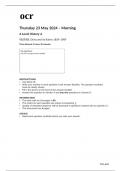Overig
applied science unit 4 assignment C synthesising an Aspirin
- Vak
- Instelling
This is BTEC level 3 Applied science unit 4 assignment C synthesising an aspirin . The assignment is written to distinction standards. This assignment goes through each criteria in much detail. I hope you find my assignment useful .
[Meer zien]












